by Navdanya and Navdanya International
In January 2020, the Gates foundation launched “The Bill & Melinda Gates Agricultural Innovations LLC”, also known as “Gates Ag One”. Gates Ag One was formulated to be a subsidiary of the Gates Foundation and is to be led by Joe Cornelius, the previous director of the BMGF Global Growth & Opportunity Division. Cornelius is a former food, nutrition and technology development executive at Bayer Crop Science and in the 1990s was Director for International Development at Monsanto.[1]
Gates Ag One is being hailed as a new non-profit to “bring scientific breakthroughs to smallholder farmers whose yields are threatened by the effects of climate change” and shrink the supposed ‘productivity gaps’ present in Africa, Asia, and Latin America.[2] It will work with the Gates Foundation’s Agricultural Development Team and other partners across sectors to “accelerate the development of innovations” that are “needed to improve crop productivity and help smallholder farmers, the majority of whom are women, adapt to climate change”.[3]
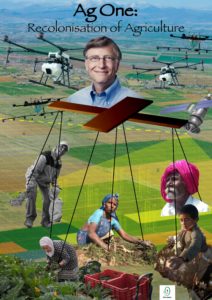
The goal of Gates Ag One is claimed to be “to empower smallholder farmers with the affordable, high-quality tools, technologies, and resources they need to lift themselves out of poverty.” According to its creation document, “yields on farms in these regions are already far below what farmers elsewhere in the world achieve, and climate change will make their crops even less productive.”[4]
Rodger Voorhies, current president of the Gates Foundation’s Global Growth & Opportunity division, has said that Gates Ag One plans to work with partners from the public and private sector to commercialize “resilient, yield-enhancing seeds and traits”. He adds, “We needed to accelerate the access to the kinds of products and services that low income people and smallholder farmers need,” due to the long time it takes to move from invention, to development, to lab testing and then through regulation.[5] Voorhies explains, “We didn’t think that research was flowing down to the crops that matter most to smallholder farmers in a timeframe that could reach them…But ultimately the Gates Foundation did not see another way to ensure that early-stage discoveries, such as water use efficiency for crops that will face extremes of droughts and floods, are made accessible and affordable to smallholder farmers as quickly as possible.”[6] In short, they are hoping to artificially accelerate the process of introducing ‘new technologies’ to farmers through increased investment and public and private partnerships while having total freedom in their business model as a separate entity to the Bill and Melinda Gates Foundation.
Where will it work?
In a document released by the Gates Foundation itself, it is claimed that Ag One will work in “South Asia – with a population of about 1.8 billion – and Sub-Saharan Africa- home to around 1 billion people.”[7]
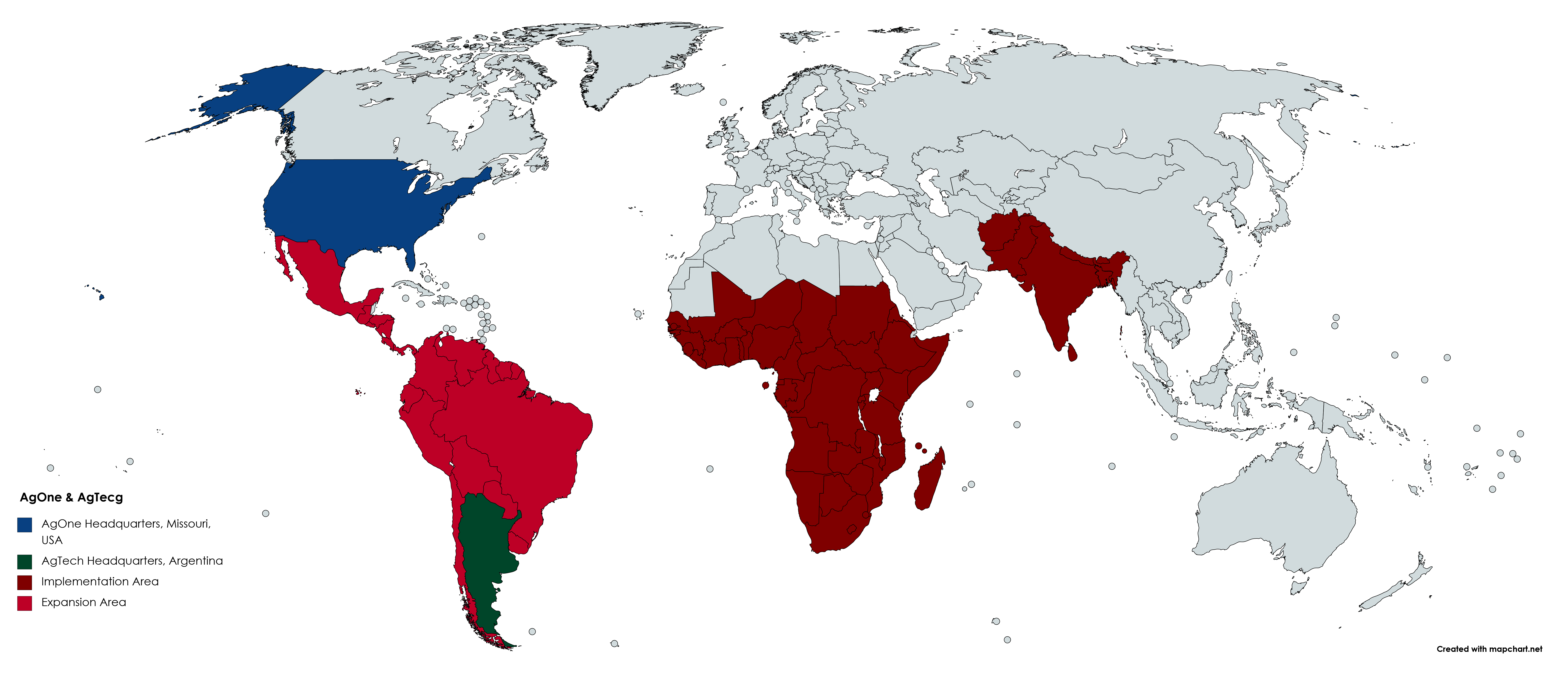
What is not mentioned in their creation statement is the implementation of the Ag One programme in Latin America, ‘Ag Tech’. This will operate, through a partnership with the Inter-American Institute for Cooperation on Agriculture (IICA).[8] The programme’s starting point is planned to be in Argentina, followed by the rest of Latin America.
Ag One, Gates Global Commission on Adaptation and the takeover of the CGIAR system
Overlapping behind several of the initiatives launched by Bill and Melinda Gates, is a characteristic urgency that all new technologies and mitigation efforts must be pushed, adopted and quickly implemented in the name of stopping climate change. This rhetoric stands to mask a wide section of the Gates’ initiatives, organizations, and funding schemes whose real purpose runs counter to any type of true climate change alleviation.
The same is true for Ag One, as it was launched as the final cornerstone of Gates Global Commission on Adaptation[9] 2019 year of Climate action.[10] The Global Commission on Adaptation is another, separate Gates initiative focused on pushing technological solutions to climate change adaptation and mitigation, through such things as filling in the ‘data gap’ of the global south, green smart cities, and increased development (and return investment) opportunities through these efforts. Ag One was, launched as the extension of these ‘mitigation’ efforts into agriculture.
The Global Commission on Adaptation hosts as its co-chairs, along with Gates, some international organization heavyweights such as the previous 8th secretary general of the UN, Ban-Ki Moon who serves as the head of the organization’s board, and Kristalina Georgieva, the current managing director at the International Monetary Fund (IMF).
Forming part of Ag One’s strategy will be the doubling of funding to CGIAR, an organization Gates has had his eye on for quite some time. Hence, in September of 2019 at the UN Climate Summit, and as part of the Gates Global Commission on Adaptation’s year of climate action, CGIAR announced the gift of more than $79 million dollars from a coalition headed by Bill Gates, and made up of the World Bank, the UK, the Netherlands, the European Commission, Switzerland, Sweden and Germany. [11] According to the CGIAR announcement, “US $310 million [is to be given by] the Bill & Melinda Gates Foundation over the next three years to support CGIAR’s shared agenda to tackle climate change and make food production in the developing world more productive, resilient and sustainable. The foundation is the second largest donor to CGIAR after the US Agency for International Development (USAID), with investments contributing to work in crop breeding, seed systems, gender equity, livestock, nutrition, and policy.”[12] Thus aligning the vision of CGIAR with that of Ag One.
This move is more significant still. As a recent ETC report states, a new System Reference Group (SRG) delivered recommendations in July 2019 calling for the formal consolidation of the 15 Centers of the CGIAR into one. The meeting of the 15 Center Chairs was convened at Biodiversity International (BI) headquarters outside Rome in December 2019 to discuss the “mega-merger”. The consolidation would involve one international board which would be responsible for all 15 Centers.[13] The dangers of this reorganisation emerges when one looks deeper and sees that the SRG is co-chaired by Tony Cavalieri, Senior Program Officer of the Bill & Melinda Gates Foundation, and Marco Ferroni, Chair of the System Management Board and recently retired as head of the Syngenta Foundation. The unification, which is being pushed by the Gates and Syngenta Foundations, USAID, the UK, Canada, Australia and Germany will mean an even stronger blurring of lines between the private and public sectors. Private agendas of making profits will be clothed as the public agenda. These agendas will be even further blurred through the launching of Ag One. This merger also provides unprecedented leverage on individual country policies and mass access to genetic seed resources. This hunger for influencing global food policy comes as no surprise; as the Gates Foundation website itself states, “a key trigger of agricultural transformation is a conducive policy environment.”[14]
When one reads the agenda of the newly launched Ag One, one can also not help but think of the rhetoric of 2008 which launched the Alliance for the Green Revolution in Africa or AGRA, which essentially served to revamp the ghost of the already dead and failed Green Revolution of the 1960s. Considering its multiple alliances to agrochem companies, one can only assume Ag One is meant to pick up AGRA’s baton with a new tech twist and run to the rest of the global south.
The Poison Cartel and the Gates Foundation
Ag One claims to “empower smallholder farmers” by providing more accessible technology to help them face climate change. This sounds eerily like Bayer who also claims, “by 2030, [they] committed to empowering 100 million smallholder farmers in developing regions by improving access to agronomic knowledge, products, services, and partnerships.”[15] Through looking at examples of current and past co-investments, one can start to see what ‘private-partnerships’ will most likely emerge in Ag One’s quest to “empower smallholder farmers to lift themselves out of poverty.” In 2010, a US financial website published the Gates foundation’s annual investment portfolio, which showed it had bought 500,000 Monsanto shares at around $23m.[16] Ag One will be based in St. Louis, Missouri USA, home of Monsanto.
More recently, research has revealed Gates’ annual investment portfolio, or “strategic investment fund” which is tasked with allowing the foundation to advance its ‘philanthropic goals’ through investments in for-profit companies. For example, his investment portfolio shows a $7 million equity stake in AgBiome, a biotech start-up focused on developing synthetic biological products through CRISPR technology for the agricultural sector.[17] AgBiome investors include agrochem companies Monsanto and Syngenta and it has received a $20 million grant from the Gates foundation to develop pesticides for Africa. [18]
This shows just one of the numerous ventures in which the Bill and Melinda Gates Foundation and Monsanto have co-invested together with a false narrative such as “helping the poor in South Africa”. As another example, Pivot Bio, a biotech startup that focuses on making nitrogen fixing microbes, received $70 million dollars from the Gates Foundation and holds investments from Monsanto Growth Ventures and the US’s Defense Advanced Research Projects Agency or DARPA.[19]
More explicitly, with the launch of the Latin American version of Ag One, ‘Ag Tech’, IICA has announced implementation partnerships with Microsoft[20], Bayer[21], Corteva (a subsidiary of DuPont)[22], and Syngenta[23], all along with the Bill and Melinda Gates Foundation.
By looking to the outcomes of AGRA we can start to see a repeating pattern with all these strategic alliances in the launching of Ag One. Through the Gates Foundation’s promotion of chemical and genetically modified inputs, they have worked to open up previously isolated or hard to reach markets in Africa, South Asia and Latin America for the benefit of private corporations, as these patented agricultural technologies and investments are very clearly made to derive profits. The commercialization mentioned by Voorhies means, in effect, private company profit.
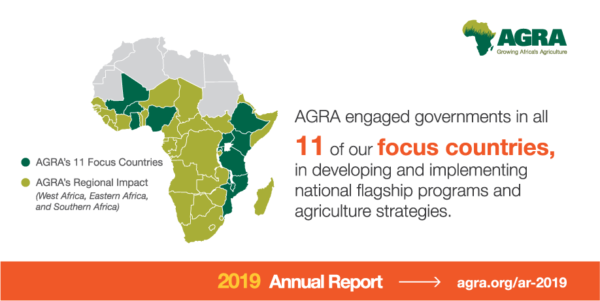
To be specific, in 2008, the year AGRA was launched, South Africa was the only African country that had approved the use of GM seeds. Subsequently, GM seeds were expanded to the previously GM-free Egypt, Burkina Faso, and Sudan. Other countries, such as Ghana, Kenya, Tanzania, Uganda, Malawi, Mali, Zimbabwe, and Nigeria have begun conducting research into GM crops. By 2017, some countries had even conducted field trials.[24] This huge expansion of GM crop use, particularly maize, is a consequence of large-scale promotion directly aimed at increasing the market share of the large agribusiness companies that own the patented seed. Those patented GM seeds also go along with their accoutrements of chemical inputs, all promoted through alliances with agrochemical companies under the guise of AGRA. In sum, roughly ten years after the revival of the Green Revolution through AGRA, industrial agriculture expanded in some form or another, from one country to eleven, resulting in a huge expansion in big agribusiness. As explained by Tim Wise in his report on AGRA, in 10 years, productivity rates in these countries only increased due to these inputs being highly subsidized, and were nowhere near enough to alleviate poverty and hunger.[25] Meaning only big agrochemical companies directly benefited from Gates’ push for ‘agricultural development’.
This comes as no surprise, as in a video shot by the Gates Foundation to explain the necessity of agricultural innovation, Gates describes the Green Revolution as, “the most significant advancement in human history behind modern medicine, due to its ability to drastically increase yields.”[26] With just this one statement, which shows his full scale support of industrial agriculture, we can almost guarantee this pattern will be repeated with the implementation of Ag One.
Unveiling the rhetoric of Ag One
Once one begins to look closely at the Ag One concept note, one can quickly start to pick apart how its rhetoric is completely disconnected from any lived experience of the impacts of the first Green Revolution, and its unprecedented global ecological, social, economic and cultural impacts. Contrary to what Bill Gates might think, agroecological food systems are overall more productive, more resilient to climate change, and provide greater livelihood security.
Rhetoric 1: “Yields on farms in [Sub-Saharan Africa and South Asia] are already far below what farmers elsewhere in the world achieve, and climate change will make their crops even less productive.” Ag One seeks to, “accelerate the development of innovations… they need to sustainably improve crop productivity…” [27]
Counter: Contrary to the myth that small farmers and their agroecological systems are unproductive, and thus we should leave the future of our food in the hands of the Poison Cartel, small farmers are providing 80% of global food using just 25% of the land that goes into agriculture.[28] There have also been countless studies that have proven that agroecological, organic agriculture, especially those based on biodiversity, are all around more resilient to climate change, more economically viable and lead to increases in crop productivity.[29] For example, biodiversity helps reduce diseases, improving the resilience of crops and leading to higher yields.
The diversity of knowledge embedded in agroecological and traditional farming systems also provides a greater safety net for confronting extreme weather patterns and ecological shifts. As stated by Altieri et al. in the study of the climate resilience of agroecological systems, “Observations of agricultural performance after extreme climatic events (hurricanes and droughts) in the last two decades have revealed that resiliency to climate disasters is closely linked to farms with increased levels of biodiversity.”[30]
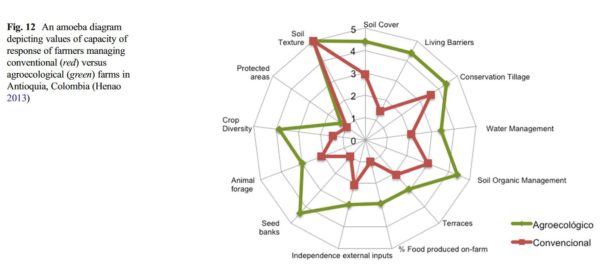
Rhetoric 2: “The goal of Gates Ag One is to help the foundation deliver on its mission to empower smallholder farmers with the affordable, high-quality tools, technologies, and resources they need to lift themselves out of poverty.” [31]
Counter: Reliance on internal inputs and recycling of resources avoids the cash strain of costly chemical inputs. Coupled with increased productivity, this means farmers are better able to meet their monetary needs and overall livelihoods. This fact was corroborated in a study presented at the 2nd International Conference on Global Food Security, through looking at global comparative data. The study found that adopting agroecological farming practices, generally led to increased crop yield and profitability in comparison to conventional practices. [32]
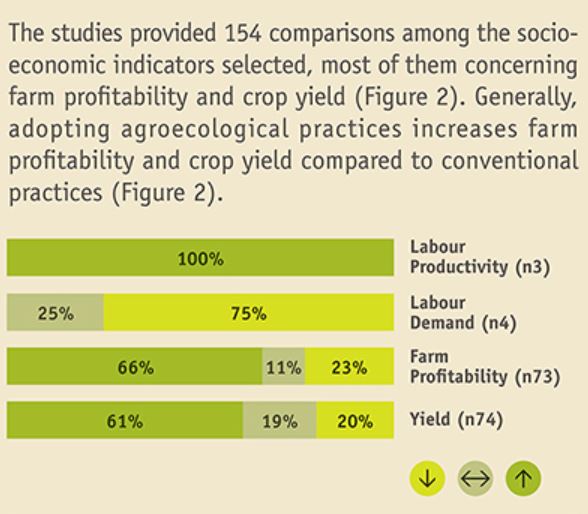
So, this begs the question, does being lifted out of poverty mean being folded into the commodity market? Considering Gates’ longstanding alliance with giant industrial agriculture companies, this is most likely the objective. While farmers have bred hundreds of thousands of varieties of thousands of species, the Green Revolution helped reduce the agriculture and food base to a handful of globally traded commodities, with only 30 plants supplying 95% of global food demand.[33] Genetic Engineering has further narrowed the commercially planted crops to four – Corn, Soya, Cotton, Canola and 2 traits – BT and HT (herbicide tolerant). This reduction of marketable crops also creates an oversupply of commodity crops which keep prices low, making it all the more difficult for small-scale commodity farmers to make a living.
Regardless, such a simplistic view of solving poverty simply with technological innovation reduces the multidimensionality of why certain populations remain poor.
Through this and similar rhetoric, Gates pushes the philanthropist ethic where the rich give to the poor, painting the rich as providing favors to the poor they exploited to gain their wealth. In the end making the poor ever more dependent on the rich. Coupled with his development agenda, a chimera of charity development emerges which reinforces the power structures of inequality in the areas where they work, reiterating the trope of white saviorism.
For example, Gates chief scientist at Microsoft Azure Global, Ranveer Chandra who is in charge of developing sensors for data gathering on farms through the FarmBeats project, has himself, as has Gates, readily admitted they have no expertise in agronomy, biology, farming or related fields, but they still believe that through computer and data science they can solve complex multidimensional ecological and social problems, such as poverty.[34] Reiterating the trope of the technical expert who comes to bestow upon the poor their knowledge, never leading to empowerment but only to dependence. In the end this reductionist way of implementing top-down technologies works to deepen global poverty through creating further dependence on centralized high-cost inputs.
Rhetoric 3: “Smallholder farmers need new innovations to help them adapt. Without these innovations, farmers will be forced into increasingly unsustainable practices to feed their families while coping with climate change—like expanding crop production and grazing into forests and other fragile ecosystems. Such tactics would further damage the environment and exacerbate the effects of climate change.” [35]
Counter: Commodity based, fossil fuel intensive, monocultural industrial agriculture is, by far, more responsible for the effects of climate change and ecosystem destruction.[36] Chemical pesticides are directly responsible for the mass killing of birds and insects.[37] Fossil fuels are used in almost every step of the industrial food system—in the field through nitrogen fertilizers, diesel fuel for the myriad of industrial agricultural equipment, to transportation of commodities in the international supply chain, their storage, and eventually their disposal.[38] Nitrogen fertilizers also pollute water sources, dry out land and destroy soil.[39] Leading, overall, to more water being necessary in industrial agriculture leading to furthering the global water strain.[40]
The true culprit of large-scale deforestation has been the industrial agriculture sector, which seeks the perpetual amplification of the agricultural frontier and is responsible for 70-90% of global deforestation.[41] The land cleared is then used for the production of chemically intensive monocultures of commodity crops like maize, soy, sugarcane, cotton, palm oil and so on. These crops are then used in industrial food making processes, biofuels, or animal feed – creating a vicious cycle of GHG emissions with the other areas of the industrialized food system.[42] Gates seems to completely disregard this, as in 2016, he invested $14 million into biofuel conversion company Renmatix. Renmatix produces a technology to aid in the conversion of biomass to cellulose sugars for biofuels.[43] Biofuels have been responsible for the clearance of rainforests all around the world, especially in the Brazilian Amazon, not small farmers.[44]
By framing the narrative in a way that pins the responsibility for climate change on “smallholder farmers who are involved in unsustainable practices” the Gates foundation evades responsibility for the destruction it has been instrumental in causing. We cannot address climate change, and its very real consequences, without recognising the central role of the industrial and globalised food system, actively supported by the Gates Foundation. The globalised food system contributes from 44% to 57% of all greenhouse gas emissions through deforestation, industrial inputs (such as chemical fertilizers, petrol, fertilizer, irrigation and so on), animals in concentrated animal feeding operations (CAFOs), plastics and aluminium packaging, long distance transport and food waste.[45]
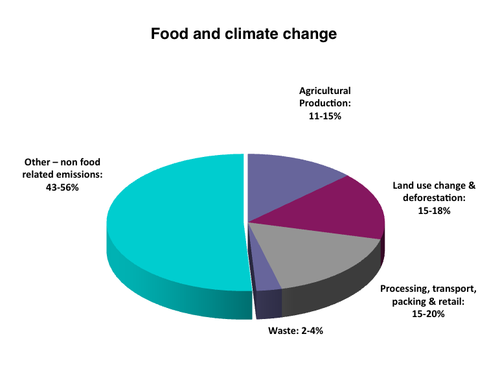
We cannot solve climate change without small-scale, ecological agriculture, based on biodiversity through living seeds, living soils, and living and local food systems. A proven way to decrease CO2 emissions is exactly through local food economies that eliminate fossil fuel intensive methods and global supply chains, replacing them with resource recycling, low intensity inputs to heal the soil, and biodiversity. Slow, whole, organic diets increase nutrition and lessen climate impact in a multidimensional fashion. [46]
Rhetoric 4: “At the Bill & Melinda Gates Foundation, we believe that everyone has the right to live a healthy, productive life. But many of the world’s poorest people—those who make their living through agriculture—will not have that opportunity unless they can access the innovations needed to adapt to the challenges caused by climate change.”……..“Gates Ag One, aims to speed up efforts to provide smallholder farmers in developing countries, the many of whom are women, with access to the affordable tools and innovations they need to… adapt to the effects of climate change.”[47]
Counter: They make it sound like farmers cannot live a healthy and productive life without technology. They also make it sound like the only way to face climate change is with the help of their “innovations” when they will profit massively from them. Through this elevation of technological means to human ends, the corporate agenda is made the human agenda: imposition is defined as “inclusion” or “Democratization”. Corporations endow their tools with inevitability and rob societies of thinking of options and alternatives. However, there is no inevitability in the tools humanity uses. Chemicals and the Green Revolution were not inevitable. They were imposed through conditionalities.[48] The failures of the Green Revolution and its ‘innovations’ do not provide a solid base for the argument of new technological innovations.[49] Technology itself also greatly impacts climate change through the whole chain of its material extraction, production, distribution and waste processing.[50] A new technological fundamentalism is making corporate tools a measure and indicator of human progress, immune from social and democratic assessments.
With the ecological emergency, climate emergency and the food emergency, the technologies that are needed are participatory and evolutionary, breeding for climate resilience, for increasing nutrition, and making agriculture poison free.
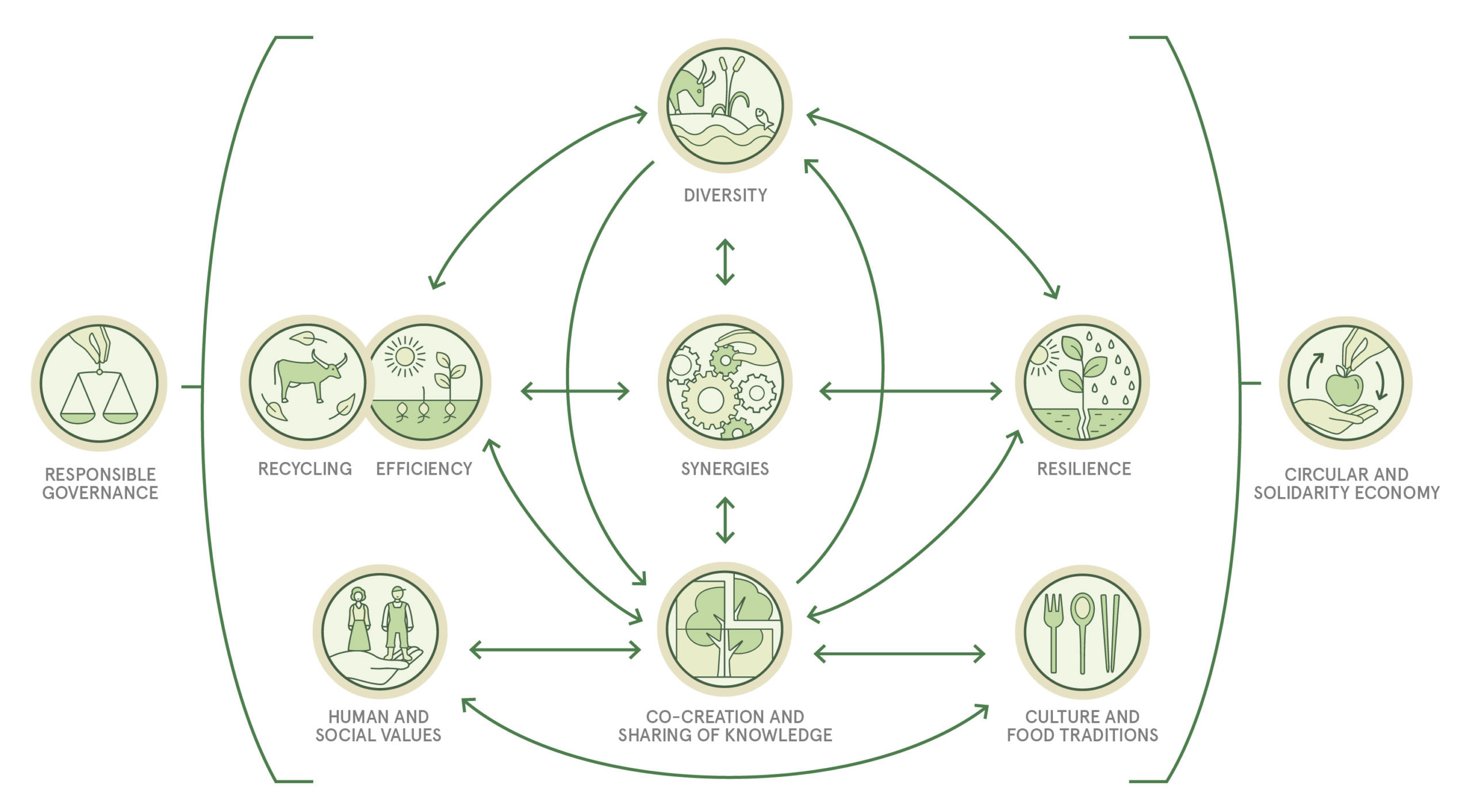
The urgency implied around the need for technological solutions to climate change provides the guise through which can be pushed the universal adoption of a new series of data-reliant technologies. Since climate change is ‘new’ there must also be a ‘new, innovative’ solution to solve it, leading to a new wave of epistemic colonisation. “One Agriculture One Science”[51] essentially means “one research and one knowledge”. In a world of diversity, claiming to be the “One” is a design for Imperialism. It is a design for epistemic colonisation. It is a denial of the richness of agroecological knowledges and practices that are resurging around the world.
Ag One: Sowing the Seeds of Surveillance
We have seen how the new Ag One initiative will line up with previous iterations of Gates’ attempt to expand the failed methods of the classic Green Revolution; but Ag One also envisages the unveiling of a new generation of external input technologies. The focus of Ag One is to transition small farmers to use ‘new digital tools and technologies’. Principally referenced are the ‘yield-enhancing’ or drought tolerant seeds which include old and new types of GMOs, as well as the use of gene editing technologies on seeds and living plants.
Gates has been pushing for CRISPR and gene editing for several years now. In 2016 an investment firm called bngO headed by former science advisor to Gates, Boris Nikolic, and of whom Gates is a backer, provided a huge seed investment of $120 million dollars to fund Cambridge’s Editas Medicine- one of the first to research and develop CRISPR technology.[52] Since then he has publicly expressed his full-fledged support of CRISPR for its use in agriculture and medicine.
The other most important aspect is the use of digital agricultural extension through sensors to gather data points on everything; from mapping soil moisture, weather patterns, soil nutrient levels, individual plant health and so on. The end purpose of such sensors is to fill the ‘data-gap’ of the global south and provide data as a resource in order to build maps and predictive models of agricultural systems. Big data, data analytics and machine learning are, hence, being incorporated into agriculture through electronic tracing systems, electronic weather data, smartphone mapping and other remote sensing applications, all in order for AI and machine learning to be able to model such things as: when to plant the next season of crops, when to water, when to fertilize or predicting pest outbreaks.
This new type of data-reliant agriculture is oriented toward the implementation of precision agriculture, which is essentially a “data-generating agriculture” as it is based on observing and measuring crops, environment variables using sensors and satellites, to supposedly lower the use of chemical inputs. But in the end precision agriculture is a double edge sword. On the one hand it is just a way to placate critiques of the high costs of using chemical inputs, while on the other providing the means to reduce farmers to possible data sets to generate artificial models. This in turn reduces the world’s diversity to merely an environment to improve predictive models through the complete disregard for (even the concept of) living systems.
Data mining from Farmers
Such experiments with data mapping are already underway. For example, in India, Digital Green, an initiative of the Gates Foundation, is described as “a global development organization that empowers smallholder farmers to lift themselves out of poverty by harnessing the collective power of technology and grassroots-level partnerships.”[53] It is an NGO that focuses on “training farmers to make and show short videos where they record their problems and share solutions”. Digital Green was first conceived of by Microsoft Research in India in 2006 before becoming an independent NGO.[54] Since then, it has received $1.3 million dollars of funding from the Walmart foundation while their South Asia Food and Nutrition Security Initiative (SAFANSI) is funded by the World Bank. It received Rs 3 crore ($400,600) as a Global Impact Award from Google in 2013. The Bill and Melinda Gates Foundation has provided more than $10 million towards this initiative.

Source: https://www.sciencedirect.com/science/article/pii/S0308521X16303754
This “data” from farms and farmers is being collected without their knowledge or prior consent. Problematically, this “data” is also closely tied to farmers’ personal information, like the location of the farms, their yields and other sensitive information. Farmers also have little say as to what happens to the data being collected. This brings in questions of data sovereignty, as the data being collected is more than likely to be developed into products that are then sold back to farmers as essential for successful digital farming. In turn, the very institutions that are pushing for this new data-ag and its regulation are indirectly or directly in the hands of the Gates Foundation. The most blatant example being the World Economic Forum’s World Food Systems Summit (WFSS), to be hosted in 2021, which is to be headed by former Rwandan Minister of Agriculture and president of (Gates-funded) AGRA (Alliance for a Green Revolution in Africa). In the concept paper for the summit there was no mention of agroecology, indigenous peoples or civil society. But it does specifically mention precision agriculture and genetic engineering as important for addressing future food security, while also expressing vocal support for the fourth industrial revolution around data.
For the countries where Ag One is looking to operate there is very little legislation, regulation, nor concrete trade agreements around digital data transfers, leaving countries in the global south with little capacity to handle this new influx of ‘data resources’. This leaves them even more vulnerable to further predation by large corporations. Gates’ digital agenda with Ag One will also serve to exacerbate this already stark power inequality through a centralization of all farming data out of the hands of farmers. This centralization also then leaves the door open for further biopiracy, centrally managing data that can only be accessed through paywalls, surveillance, and further policing by big corporations of their product use and so on.
The pivotal example of these consequences is the biopiracy being carried out through the convergence of information technology and biotechnology by taking patents through “mapping” genomes and genome sequences[55]. While living seed needs to evolve “in situ”, patents on genomes can be taken through access to seed “ex situ”. This undermines farmers’ rights as permission from the farmers is no longer necessary once the genome has been digitally mapped.153F[56]
Making time an enemy: A Push for Deregulation
All of this is only possible through an agenda of active deregulation. Using the rhetoric of climate change as the cause for extreme urgency, according to Rodger Voorhies, president of Gates’ Global Growth & Opportunity division, “Research and development takes years to get from the lab to the field, and while the Agricultural Development team funds the development of new tools and technologies designed to meet the needs of smallholder farmers, there were delays in translating these discoveries to affordable products”. He added, “we didn’t think that research was flowing down to the crops that matter most to smallholder farmers in a timeframe that could reach them.”[57] But for Ag One this acceleration is only possible through the deregulation of biosafety. The objective of Ag One seems to be to fund these new innovative scientific discoveries with the goal of getting them as quickly as possible to the point of commercialisation with as little testing, assessment and regulation as possible. One such example is of CRISPR and gene editing where they have tried to bypass regulation altogether by claiming that gene editing is a non-GMO technology.
Building on Thousands of Years of Evolution of Thousands of Diverse Agroecological Knowledges and Cultures
There is an illusion that running faster on the chemical and poison cartel treadmill, now equipped with artificial intelligence and robots, will be more effective in producing more food and feeding the hungry. On the contrary, the tools and technologies of the poison cartel have brought the planet and the lives of farmers to the brink with climate havoc, species extinction, water crisis, farmer incomes collapsing to zero, and food related diseases killing larger numbers of people.
In the end it appears that Gates’ new Ag One initiative is the same wolf in different clothing, where he is attempting to push faster and harder for the whole world to adopt his version of the already failed Green Revolution with a new tech twist. A worldview which is completely disconnected from the realities of small farmers and their need for food sovereignty.
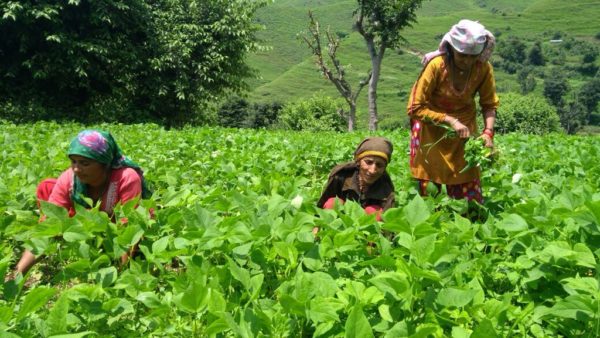
As shown, the future of agriculture is based on biodiversity, seed sovereignty and agroecology, not on “Ag One” or “Ag Tech”. We need to rise up and look past the corporate narrative and look to time tested indigenous knowledge and Agroecology to shape the future of Agriculture based on Biodiversity and Cultural Diversity. We need a rejuvenation of small farms, real farms with real people who care for the land, who care for life, who care for the future and who do produce diverse, healthy, fresh, ecological and real food for all.
This article is extracted from a new multi-author report from Navdanya International titled Gates to a Global Empire documenting the perils of philanthrocapitalism.
Footnotes
[1] Gray, Bryce. “Gates Foundation Plans Crop Research Center in St. Louis.” Online Research Library: Questia | St Louis Post-Dispatch (MO), January 30, 2020. https://www.questia.com/newspaper/1P4-2348219385/gates-foundation-plans-crop-research-center-in-st
[2] “Overview: Bill & Melinda Gates Agricultural Innovations.” Bill & Melinda Gates Foundation, January 2020. https://docs.gatesfoundation.org/Documents/GatesAg One_OverviewandFAQ.pdf
[3] Ibid.
[4] “Gates Foundation on Intention to Create Nonprofit Agricultural Research Institute.” Bill & Melinda Gates Foundation | Press Releases, January 21, 2020. https://www.gatesfoundation.org/Media-Center/Press-Releases/2020/01/Gates-Foundation-Statement-on-Creation-of-Nonprofit-Agricultural-Research-Institute
[5] Cheney, Catherine. “Exclusive: Gates Foundation Launches New Agriculture-Focused Nonprofit.” Devex. Last modified January 21, 2020. https://www.devex.com/news/sponsored/exclusive-gates-foundation-launches-new-agriculture-focused-nonprofit-96384
[6] Ibid.
[7] Ibid.
[8] “Microsoft y El IICA Definieron Hoja de Ruta Para La Transformación Digital Del Agro de Las Américas.” Instituto Interamericano de Cooperación Para La Agricultura (IICA). https://www.iica.int/en/node/16190
[9] “About.” Global Center on Adaptation. https://gca.org/about
[10] “Global Coalition Promises More than $650 Million to Accelerate CGIAR Efforts to Help 300 Million Smallholder Farmers Adapt to Climate Change.” CGIAR, September 23, 2019. https://www.cgiar.org/news-events/news/uncas-global-coalition-funds-cgiar/
[11] Ibid.
[12] Ibid.
[13] “The Next Agribusiness Takeover: Multilateral Food Agencies.” ETC Group. Last modified February 12, 2020. https://www.etcgroup.org/content/next-agribusiness-takeover-multilateral-food-agencies
[14] “Agricultural Development.” Bill & Melinda Gates Foundation. https://www.gatesfoundation.org/What-We-Do/Global-Growth-and-Opportunity/Agricultural-Development. https://www.gatesfoundation.org/What-We-Do/Global-Growth-and-Opportunity/Agricultural-Development.
[15] “Our Commitment to Smallholder Farmers.” Bayer Cropscience, https://www.cropscience.bayer.com/who-we-are/sustainable-agriculture/our-commitment-to-smallholder-farmers. Accessed 30 Oct. 2020.
[16] Vidal, John. “Why Is the Gates Foundation Investing in GM Giant Monsanto?”. The Guardian, September 29, 2010. http://www.theguardian.com/global-development/poverty-matters/2010/sep/29/gates-foundation-gm-monsanto
[17] Schwab, Tim. “Bill Gates’s Charity Paradox.” The Nation, March 17, 2020. https://www.thenation.com/article/society/bill-gates-foundation-philanthropy/
“Platform | AgBiome.” https://www.agbiome.com/platform/
Burwood-Taylor, Louisa. “Bill & Melinda Gates Foundation Makes First Agtech Investment in AgBiome’s $34.5m Series B.” AgFunderNews, August 20, 2015. https://agfundernews.com/bill-melinda-gates-foundation-first-agtech-investment-agbiome-011.html
[18] Ibid.
[19] Vinluan, Frank. “Pivot Bio Gets $70M, Led by Bill Gates’s Fund, to Replace Fertilizer – Page 2 of 2.” Xconomy. Last modified October 2, 2018. https://xconomy.com/san-francisco/2018/10/02/pivot-bio-gets-70m-led-by-bill-gatess-fund-to-replace-fertilizer/
[20] “Microsoft e IICA Firmaron Un Acuerdo Para Potenciar El Uso de Tecnología En El Agro | Solo Campo.” Last modified December 24, 2018. http://solocampo.com.ar/index/microsoft-e-iica-firmaron-un-acuerdo-para-potenciar-el-uso-de-tecnologia-en-el-agro/
[21] “El IICA y Bayer firman acuerdo para promover seguridad alimentaria en América.” Nuevos Papeles, February 7, 2019. https://www.nuevospapeles.com/nota/17625-el-iica-y-bayer-firman-acuerdo-para-promover-seguridad-alimentaria-en-america
[22] “Acuerdo entre Corteva Agriscience y el IICA fortalecerá producción de alimentos de calidad en las Américas.” Instituto Interamericano de Cooperación Para La Agricultura (IICA), October 31, 2019. https://iica.int/es/prensa/noticias/acuerdo-entre-corteva-agriscience-y-el-iica-fortalecera-produccion-de-alimentos-de
[23] “Syngenta y el IICA se unen para impulsar la innovación en la agricultura de las Américas.” Instituto Interamericano de Cooperación Para La Agricultura (IICA), July 7, 2020. https://iica.int/es/prensa/noticias/syngenta-y-el-iica-se-unen-para-impulsar-la-innovacion-en-la-agricultura-de-las
[24] Curtis, M. 2016. Gated Development: Is the Gates Foundation Always a Force for Good? Second Ed., Global Justice Now. June 2016. Pg. 31. https://www.globaljustice.org.uk/sites/default/files/files/resources/gjn_gates_report_june_2016_web_final_version_2.pdf
[25] Wise, Timothy A. “AGRA at Ten Years: Searching for Evidence of a Green Revolution in Africa,” November 2017. https://afsafrica.org/wp-content/uploads/2019/10/agrawiseprelimfindings2017.pdf
[26] Slideshow: Bill Gates on Agricultural Innovations – YouTube, 2009. https://www.youtube.com/watch?v=xXcB8k7Ysk4
[27] “Overview: Bill & Melinda Gates Agricultural Innovations.” Bill & Melinda Gates Foundation, January 2020. https://docs.gatesfoundation.org/Documents/GatesAg One_OverviewandFAQ.pdf
[28] “Hungry for Land: Small Farmers Feed the World with Less than a Quarter of All Farmland.” Grain, May 28, 2014. https://www.grain.org/article/entries/4929-hungry-for-land-small-farmers-feed-the-world-with-less-than-a-quarter-of-all-farmland
[29] HLPE. 2019. Agroecological and other innovative approaches for sustainable agriculture and food systems that enhance food security and nutrition. A report by the High Level Panel of Experts on Food Security and Nutrition of the Committee on World Food Security, Rome. http://www.fao.org/3/ca5602en/ca5602en.pdf
Shefali , Sharma. “Agroecology: Key to Agricultural Resilience and Ecosystem Recovery.” Institute for Agriculture & Trade Policy (IATP), June 16, 2019. https://www.iatp.org/agroecology-key-agricultural-resilience-and-ecosystem-recovery
De Schutter Olivier, Report of the Special Rapporteur for the Right to Food, A/HRC/16/49, United Nations – Human Rights Council, 2010. https://www2.ohchr.org/english/issues/food/docs/a-hrc-16-49.pdf.
Mcintyre, Beverly & Herren, Hans & Wakhungu, Judi & Watson, Robert. (2009). Agriculture at a Crossroads: The Global Report. https://www.researchgate.net/publication/258099731_Agriculture_at_a_Crossroads_The_Global_Report
[30] Altieri M.A., Nicholls C., Henao A., Lana M., Agroecology and the design of climate change-resilient farming systems, 869 – 890, 35 (3), SN 1773-0155, Springer, Agronomy for Sustainable Development, 2015, https://link.springer.com/article/10.1007/s13593-015-0285-2
[31] “Overview: Bill & Melinda Gates Agricultural Innovations.” Bill & Melinda Gates Foundation, January 2020. https://docs.gatesfoundation.org/Documents/GatesAg One_OverviewandFAQ.pdf
[32] D’Annolfo, Raffaele & Gemmill-Herren, Barbara & Graeub, Benjamin & Garibaldi, Lucas. (2015). Social and economic performance of Agroecology. https://www.researchgate.net/publication/283721240_Social_and_economic_performance_of_Agroecology
[33] FAO 2010. The Second Report on the State of the World’s Plant Genetic Resources for Food and Agriculture. Rome. http://www.fao.org/3/i1500e/i1500e.pdf
[34] How Data-Driven Farming Could Transform Agriculture | Ranveer Chandra | TEDxUniversityofRochester – YouTube. TEDx TALKS, 2018. https://youtu.be/dpVylFjT-Cw
[35] “Overview: Bill & Melinda Gates Agricultural Innovations.” Bill & Melinda Gates Foundation, January 2020. https://docs.gatesfoundation.org/Documents/GatesAg One_OverviewandFAQ.pdf
[36] IPBES (2019): Global assessment report on biodiversity and ecosystem services of the Intergovernmental Science-Policy Platform on Biodiversity and Ecosystem Services. E. S. Brondizio, J. Settele, S. Díaz, and H. T. Ngo (editors). IPBES secretariat, Bonn, Germany. https://ipbes.net/global-assessment
IPCC, 2019: Climate Change and Land: an IPCC special report on climate change, desertification, land degradation, sustainable land management, food security, and greenhouse gas fluxes in terrestrial ecosystems [P.R. Shukla, J. Skea, E. Calvo Buendia, V. Masson-Delmotte, H.-O. Pörtner, D. C. Roberts, P. Zhai, R. Slade, S. Connors, R. van Diemen, M. Ferrat, E. Haughey, S. Luz, S. Neogi, M. Pathak, J. Petzold, J. Portugal Pereira, P. Vyas, E. Huntley, K. Kissick, M. Belkacemi, J. Malley, (eds.)]. In press. https://www.ipcc.ch/report/srccl/
FAO. 2019. The State of the World’s Biodiversity for Food and Agriculture, J. Bélanger & D. Pilling (eds.). FAO Commission on Genetic Resources for Food and Agriculture Assessments. Rome. 572 pp. (http://www.fao.org/3/CA3129EN/CA3129EN.pdf ) Licence: CC BY-NC-SA 3.0 IGO.
[37] Sánchez-Bayo, F., & Wyckhuys, K. A. G. (2019). Worldwide decline of the entomofauna: A review of its drivers. Biological Conservation, 232, 8–27. https://doi.org/10.1016/j.biocon.2019.01.020
Goulson, D., Insect decline and why they matter, Wildlife Trusts, 2019, https://www.somersetwildlife.org/sites/default/files/2019-11/FULL%20AFI%20REPORT%20WEB1_1.pdf
Brain RA, Anderson JC. The agro-enabled urban revolution, pesticides, politics, and popular culture: a case study of land use, birds, and insecticides in the USA. Environ Sci Pollut Res Int. 2019;26(21):21717-21735. doi:10.1007/s11356-019-05305-9
Gabbatiss, J., ‘Shocking’ decline in birds across Europe due to pesticide use, say scientists, The Independent, 21 march 2018, https://www.independent.co.uk/environment/europe-bird-population-countryside-reduced-pesticides-france-wildlife-cnrs-a8267246.html
[38] La Vía Campesina and GRAIN. “Food Sovereignty: Five Steps to Cool the Planet and Feed Its People.” Grain, December 15, 2014. https://www.grain.org/article/entries/5102-food-sovereignty-five-steps-to-cool-the-planet-and-feed-its-people
[39] Mateo-Sagasta, J., Marjani Zadeh, S., & Turral, H. (2018). More people, more food… worse water? – Water Pollution from Agriculture: a global review. FAO. http://www.fao.org/documents/card/en/c/CA0146EN
Rodríguez-Eugenio, N., McLaughlin, M. and Pennock, D. 2018. Soil Pollution: a hidden reality. Rome, FAO. 142 pp. http://www.fao.org/3/I9183EN/i9183en.pdf
[40] “Organic vs Conventional.” Rodale Institute. https://rodaleinstitute.org/why-organic/organic-basics/organic-vs-conventional/
[41] “Food and Climate Change: The Forgotten Link.” Grain, September 28, 2011. https://www.grain.org/e/4357
[42] Ibid.
[43] Renmatix. “Renmatix Secures $14M Investment from Bill Gates and Total, the Global Energy Major, In Concert with Signing of 1 Million Ton Cellulosic Sugar License,” September 15, 2016. https://renmatix.com/uploads/renmatix-bulletin-gates-press-release.pdf
[44] “Sugar Cane, Palm Oil, and Biofuels in the Amazon.” Yale School of the Environment | Global Forest Atlas, n.d. https://globalforestatlas.yale.edu/amazon/land-use-and-agriculture/biofuels
[45] Ibid.
[46] Ibid.
[47] “Overview: Bill & Melinda Gates Agricultural Innovations.” Bill & Melinda Gates Foundation, January 2020. https://docs.gatesfoundation.org/Documents/GatesAg One_OverviewandFAQ.pdf
[48] Ibid.
[49] Shiva, V. (1991). The Violence of the Green Revolution: Third World Agriculture, Ecology, and Politics. Other India Press. https://books.google.it/books?id=jPNRPgAACAAJ.
[50] ICTworks. “Digital Technologies Are Part of the Climate Change Problem.” ICTworks, February 20, 2020. https://www.ictworks.org/digital-technologies-climate-change-problem/
[51] Akbar, Syed. “One Agriculture-One Science: Partnership to Revitalize Global Farm Education | India News – Times of India.” The Times of India, July 22, 2014. https://timesofindia.indiatimes.com/india/One-agriculture-one-science-Partnership-to-revitalize-global-farm-education/articleshow/38867896.cms
[52] “$120 Million-Investment for CRISPR Technology From Bill Gates and Other 13 Investors.” CD Genomics, October 16, 2018. https://www.cd-genomics.com/blog/120-million-investment-for-crispr-technology-from-bill-gates-and-other-13-investors/
[53] “About Us.” Digital Green. https://www.digitalgreen.org/about-us/
[54] “About Us.” Digital Green, https://www.digitalgreen.org/about-us/. Accessed 30 Oct. 2020.
[55] Lucchi, N. (2013). Understanding genetic information as a commons: From bioprospecting to personalized medicine. International Journal of the Commons, 7(2), 313–338. DOI: http://doi.org/10.18352/ijc.399
[56] Masucci M., Un accordo per tutelare la biodiversità agricola, Terra Nuova, 16 February 2020, https://www.terranuova.it/Il-Mensile/Un-accordo-per-tutelare-la-biodiversita-agricola/
[57] Cheney, Catherine. “Exclusive: Gates Foundation Launches New Agriculture-Focused Nonprofit.” Devex, January 21, 2020. https://www.devex.com/news/sponsored/exclusive-gates-foundation-launches-new-agriculture-focused-nonprofit-96384
Editor’s note. We welcome comments and information about the subject of this article. However, please note that the “reply” function in the comments section is not working for people without high level access to the website. There are two possible solutions for readers wanting to reply to specific comments:
1) Enter your comment but name the commenter you are responding to (if necessary with the date of their comment). Or,
2) Mail your comment to the editor: [email protected] and they will post it as a reply. Please be sure to say who/what you are replying to.
If this article was useful to you please consider sharing it with your networks.



Thank you for this important information. It’s overwhelming, but better to be informed in order to whatever i can, to the best of my ability, to starve the beast and feed the people.
Money and power do not go hand and hand with intelligence, rather money and power blind the wealthy elite with ignorance in the guise of doing good. People like Gates are not evil, they are just woefully ill informed and misguided by others as ignorant as themselves or others who are evil and have an agenda to continue the colonization of communities and pillaging of the very resources that sustain us to attain greater wealth. Greed is alive and well in the Corpocracy Gates and all empower.
Wow, there’s an awful lot of innuendo here about the ‘true’ motives of Bill Gates and the Bill and Melinda Gates Foundation (and their spinoffs, like Ag One). But it’s innuendo posing as fact, without any backup, which is troubling. I’ve actually done work for BMGF (as a contractor) — I’ve been in the building, I’ve been in meetings with leaders, I’ve heard how they talk about things and discuss objectives — and you clearly don’t have those insights. Believe it or not, Bill and Melinda are actually trying to use their money for good. Their hearts are in the right place and they are not actually trying to just add to their vast wealth. Do they and the people who work there _always_ have the correct hypothesis on the best way to help others? Nope. But they try to measure results and course correct. This whole article reads like another “George Soros is the devil” piece — just substituting Bill Gates now for George Soros. Maybe bring a little more understanding and a little less suspicion next time and you’ll wind up with a more informed and informing article.
Dan
Everyone thinks they are nice. But the Gates Foundation manipulates the evidence base and the scientific process to get the results it appears to want in agriculture (https://www.independentsciencenews.org/environment/the-gates-foundations-ceres2030-plan-pushes-agenda-of-agribusiness/) and in medicine (https://www.thenation.com/article/society/gates-covid-data-ihme/) and did the same to the supposedly open and democratic UN (https://www.independentsciencenews.org/news/gates-foundation-hired-pr-firm-to-manipulate-un-over-gene-drives/). Nor do they seek opinions of those they purport to serve. And why if they are so nice and open do their hirees come overwhelmingly from agribusiness? Why does the Foundation buy up the press? There are some really excellent articles on how the Foundation goes about its business. Their analysis doesn’t rely on Gates and his crew being ‘evil’ (nor does this article btw) but the result is perfidious all the same:
https://www.utsc.utoronto.ca/ccds/sites/utsc.utoronto.ca.ccds/files/docs/Birn%20and%20Richter%202017%20Philanthrocapitalism%20and%20the%20Global%20Health%20Agenda.pdf
https://www.lareviewofbooks.org/article/pinkers-pollyannish-philosophy-and-its-perfidious-politics/
https://thegrayzone.com/2020/07/08/bill-gates-global-health-policy/
https://www.thenation.com/article/economy/bill-gates-investments-covid/
and will only enlarge healt and economic disparities.
Are you ready to open your mind Dan?
” Control oil & you control nations;
control food & you control the people. ”
attrib. Henry Kissinger re National Security Study Memorandum 200 ( 1974 )
” implications of worldwide population growth for US security & overseas interests ”
https://en.wikipedia.org/wiki/National_Security_Study_Memorandum_200 }
https://en.wikipedia.org/wiki/Syngenta#Syngenta_Foundation
https://en.wikipedia.org/wiki/Bill_%26_Melinda_Gates_Foundation#AGRA_and_Monsanto
https://en.wikipedia.org/wiki/Information_and_communications_technology_in_agriculture
Fascinating. I think this is a great analysis grounded in a compelling perspective of the world’s economic power systems. Noting that my only experience is in Angola, I do wonder if this analysis of the intentions and presumed outcomes of Ag One creates too strong a dichotomy between mass industrial agriculture (with its externalized long term costs) and smallholder farming. Is the former really the only anticipated outcome of the type of work Ag One wants to do? Is there not a way to use some of the tools/information that Ag One has access to, to help smallholders be more efficient AS SMALLHOLDERS? Seen from the business perspective of the Global North, Angola (the Central Highlands anyway) looks like it should become one giant cash crop field – Monsanto style. But what it really needs is a million 5 hectare lots with efficient and successful smallholders. Otherwise there is zero chance of AGRICULTURAL development actually being ECONOMIC development FOR ANGOLANS. Can Ag One (and the like) help with that somehow? Can Monsanto find a new way to make money off this type of development – similar to the way the fossil fuel industry is beginning to invest in renewable energy? (Baby steps, I know.)
What a splendid dissection & commentary of this latest Gates ploy to control almost all aspects of human society.
Many thanks!!
Gates’ heart may be in the right place, but he’s clearly missed the massive body of recent knowledge of innovation and success in removing carbon from the atmosphere represented by regenerative agriculture.
Makes one cynical – and wonder what he’s trying to sell, or why in the world he failed to mention the huge change in agricultural thinking toward soil health and benefits to climate change….confounding to say the least.
I believe this interview where NASA Astronaut Terry Virts talks with Larry Kopald on how creating healthy soil can create a whole new generation of healthy foods, remove toxins from our diet and also extract massive amounts of CO2 from the air is worth listening to
Larry Kopald starts by explaining his career change from advertising exec to committed researcher and promoter of healthy soil and foods he later explains why the damage by industrial farming with chemicals and toxins goes through food the soil humans and even stop the excess CO2 in the air being taken up by plants and so helps create the negative CO2 impact of excess CO2 and global warming
Larry Kopald is a former advertising executive current director of The Carbon Underground, where he’s working to solve the world’s climate crisis by improving farming techniques and restoring soil health so that it can, once again, bring carbon out of our atmosphere and put it back underground and into plants
https://m.youtube.com/watch?v=N2919IaBbxY&list=PLOk2f-OrYte5l10Ab0jCL20iLcXs24lvK&index=14
This very informative article reads like a Bill Gates hit piece severely damaging its usefulness.
Just think how much more successful sustainable agriculture would be if Bill and Melinda Gates Foundation was funding you. This article comes through as either a Republican or Democratic, take your choice political piece. Stick with the science.
It was painful to read you trying to say something evil about big data analytics… Can’t believe you mustered the courage to find something bad to say about people collecting data, learning things from it and developing products that farmers will hopefully be willing to pay for. Meanwhile, you go to the hospital, willingly give your blood for analysis, then pay for the prescribed medicine without batting an eyelid. It seems there’s always someone somewhere who wants to find a problem with everything that Bill Gates touches. As an African who has benefitted from his work and seen first hand how BMGF delivers even much more than most bilateral country-level agreements, I stand with him.
Dear Anonymous
Does your pain and solidarity with Mr Gates have anything to do with your having an email address ending “@bmgf.com”?
How centralisation of power throuh natural asset companies is happening: Dr Shiva’s take
https://www.youtube.com/watch?v=u5YU2XhlXCI&t=116s
Interesting